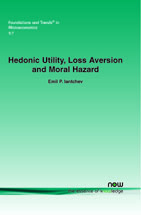Hedonic Utility, Loss Aversion and Moral Hazard
By Emil P. Iantchev, 110 Eggers Hall, Syracuse University, USA, iantchev@syr.edu
Abstract
This paper reviews recent advances in the modelling of hedonic utility and the measurement of its physiological correlates. The paper also argues that incorporating hedonic experiences can enrich economic models. An example of such an application — a principal–agent model with moral hazard — is presented and thoroughly analyzed. Its implications are then compared with the structure of incentive contracts observed in practice.
Hedonic Utility, Loss Aversion and Moral Hazard
There has been a resurgence of interest in hedonic utility, partly due to the inability of revealed preference theory to account for certain observable behaviors and partly as a result of substantial advances in brain imaging technology. Hedonic Utility, Loss Aversion and Moral Hazard summarizes these recent advances in the modeling and measurement of hedonic utility. It proposes that economists can use these studies to improve their understanding of economic phenomena by analyzing a familiar economic model-the principal-agent relationship with moral hazard-in which the properties of hedonic utility make a difference in how incentives are provided. The idea is that a profit-maximizing principal will design the incentive contract by taking into account the hedonic experiences of the agent. As a result, the optimal contract pays attention to all properties of hedonic utility. The modal transfer is exactly at the reference outcome, the value expected on average by the agent. The diminishing enjoyment of extra rewards is exploited by giving an additional bonus that increases with the level of output, while the occurrence of negative emotions due to losses is minimized by imposing only the biggest possible punishment in states where output is very low. Hedonic Utility, Loss Aversion and Moral Hazard analyzes several extensions of the basic model-competition among principals, aggregate uncertainty, and dynamics-and discuss how their implications relate to the structure of incentive contracts observed in practice. For instance, the presence of hedonic utility implies no response of the modal transfer with respect to the aggregate state of nature but an increase in the probability of the biggest punishment being implemented. In addition, by incorporating future expected outcomes in current hedonic experience, hedonic utility allows for the possibility that stationary contracts may be optimal even if the actual behavior of the agent exhibits deviations from risk neutrality.
